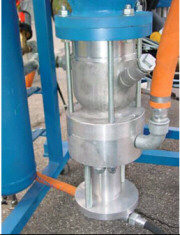E-Archive
Articles
in Vol. 4 - January Issue - Year 2003
New Media Flow Rate Control for Ferrous and Non Ferrous Media

Media Flow Rate Controller

Linearization graphic for ceramic media Z425. The Swiss manufacturer provides the control parameters for a number of different media. Should a particular media not be included in the data, the user-friendliness of this system allows an adjustment by the customer directly.

Linearization graph for steel shot S110

Media Flow Rate Unit: Looks simple from the outside, but includes sophisticated technology. To handle very fine sized media, pressure condition must be uniform in the whole system. Since certain media have a tendency to stick on critical surfaces, permanent air cleaning devices are integrated. A 5 year warranty is given for all mechanical parts!
Baiker AG, Switzerland is a manufacturer of mostly CNC controlled Dry & Wet Peening and Blasting Equipment. It mainly delivers its machinery to the Aviation and Automotive Industries. The company was founded in 1935.
Worldwide there are very few manufacturers of peening and blasting machines which are able to provide a closed loop flow rate control for non ferrous media. Baiker AG, as Swiss manufacturer of high end equipment takes it a step further by introducing one flow rate control system for any type of media no matter ferrous or non ferrous.
The different flow characteristic of media is probably the most demanding problem designing an universal media flow rate control unit. This because starting from high density steel shot with diameters of several millimeters up to dust like glass beads, an universal media flow rate control must be able to cope with any media.
In principle the new flow rate unit functions like this: The media flows onto a spring loaded cone which moves its position depending on the quantity and density of the flow. The position change of the cone is measured and turned into a signal. This signal is now used by the controller to adjust the speed of the so called dosing plate, which feeds the media to the peening or blasting hose.
However, since a particular media size and type requires the controller to use a certain set of parameters, the controller setup has to be adjusted accordingly. This can be done either on the controller directly or, much more user-friendly, on the computer of the machine's process visualization system. On request the graphs of the parameter can be printed out. Depending on the media an accuracy of ±1% (or ±30g) is reached.
The Swiss company did spend months of testing in order to collect the parameter data for all the different media. Because one does not just have to divide between the different densities of the media but also include tests for every size of media.
However, the fact that the controller uses different parameters for every media type and size explains its superior accuracy. Naturally the data set provided with the controller can never cover all applications, since there are too many, but those which are not included can be added upon request.
Additional Benefit
An end user obtaining a machine which is equipped with a closed loop media flow rate unit for ferrous and non ferrous media could find himself in a situation in which that flexibility proves to be a great advantage.
Normally one has to be strongly discouraged to switch on the same machine between e.g. steel shot media and ceramic beads. This because of the unavoidable contamination of the two media and the resulting possibility of different intensities. But in some cases a permanent change might be tolerated. As long as the new media has a greater density (resulting in a higher intensity), or if one decides to use the machine not for peening but for a surface preparation application such a change could be safe. However, one should always check with the manufacturer if it could endanger the process. Depending on the process a change from e.g. glass beads to steel shot will include modifications on the media preparation and ventilation system.
But by all means it has to be noted that this benefit concerns only a permanent change of media. Frequent changes even if they would need no further technical modification of the machine should be out of question.
Conclusion
This new flow rate control unit has become the standard for Baiker AG's peening and blasting applications. It is used not just on CNC controlled equipment but also on mobile peening units. Its outstanding flexibility and accuracy combined with unique means of process documentation certainly don't come cheap, but prove itself worthwhile within the quality driven Aviation and Automotive industries.
For Information:
Baiker AG
Dry & Wet Peening and Blasting Technology
Alpenstrasse 1, 8152 Glattbrugg, Switzerland
Tel: +41.43.2116272, Fax:+41.43.2116271
E-mail: info@baiker.ch
www.baiker.ch



























